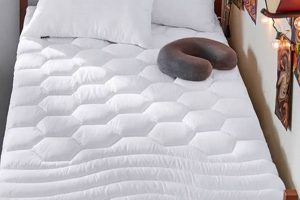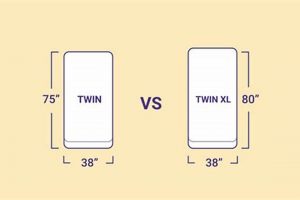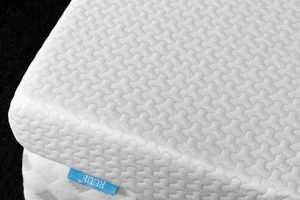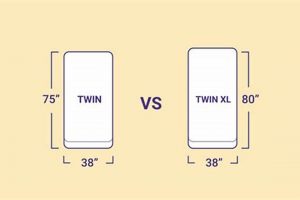These items provide a protective layer for mattresses of a specific elongated single size, commonly found in college dormitories and some guest rooms. Functionally, they act as a barrier against spills, stains, allergens, and bed bugs, extending the lifespan of the underlying mattress. A common example includes a waterproof fitted sheet designed to encase the entire mattress.
The implementation of such safeguarding elements yields several benefits. It maintains a cleaner and more hygienic sleep environment, reduces the frequency of mattress replacement due to damage, and can alleviate allergy symptoms for sensitive individuals. Historically, these types of coverings have evolved from basic fabric sheets to technically advanced materials offering enhanced protection and comfort.
The following sections will delve into specific types of these coverings, materials used in their construction, factors to consider when selecting one, and proper maintenance procedures to ensure long-term effectiveness. Considerations such as waterproof versus water-resistant options, hypoallergenic properties, and breathability will be examined.
Twin XL Mattress Protectors
Selecting and maintaining appropriate mattress coverings significantly impacts sleep hygiene and the longevity of the mattress itself. The following tips provide guidance for optimal performance.
Tip 1: Prioritize Waterproofing: Opt for a waterproof model, particularly if susceptible to spills or night sweats. This prevents liquids from penetrating the mattress, inhibiting mold and bacteria growth.
Tip 2: Consider Hypoallergenic Properties: Individuals with allergies or asthma should seek out protectors specifically labeled as hypoallergenic. These are designed to minimize the accumulation of dust mites and other allergens.
Tip 3: Evaluate Material Breathability: Breathable materials, such as cotton or bamboo, promote airflow and reduce heat buildup during sleep. Non-breathable materials can lead to discomfort and perspiration.
Tip 4: Examine the Encasement Style: Full encasement options, which zip around the entire mattress, offer superior protection against bed bugs. Fitted sheet styles provide protection primarily on the top and sides.
Tip 5: Measure Mattress Depth Accurately: Ensure the protectors pocket depth is sufficient to accommodate the mattress’s thickness. An improperly fitted protector can compromise its effectiveness and cause discomfort.
Tip 6: Follow Washing Instructions Carefully: Adhere to the manufacturer’s washing and drying instructions to maintain the protector’s integrity. High heat can damage waterproof membranes and shrink certain fabrics.
Tip 7: Regularly Inspect for Damage: Periodically examine the protector for tears or punctures. Promptly repair or replace damaged protectors to ensure continued protection.
Selecting and maintaining an appropriate protector ensures a clean, hygienic sleep environment and extends the life of the underlying mattress. By considering factors such as waterproofing, hypoallergenic properties, and material breathability, consumers can make informed decisions.
The following sections will discuss the various types of stains and damage and the process of cleaning “twin xl mattress protectors”.
1. Waterproof Barrier
The integration of a waterproof barrier within “twin xl mattress protectors” is a critical design element directly influencing the mattress’s longevity and hygiene. The primary cause-and-effect relationship is evident: the absence of a waterproof layer allows liquids, such as spills or bodily fluids, to penetrate the mattress fibers. This penetration fosters an environment conducive to mold and bacterial growth, leading to unpleasant odors, potential health hazards, and accelerated mattress degradation. A common example is the staining and damage observed on mattresses in college dormitories, where spills are more frequent. Therefore, the waterproof barrier serves as a crucial preventive measure, safeguarding the mattress core from irreversible damage.
The practical significance of understanding this connection lies in making informed purchasing decisions. Protectors featuring high-quality waterproof membranes, such as polyurethane or thermoplastic polyurethane (TPU), provide a robust defense against liquid intrusion while maintaining breathability to some extent. In contrast, protectors with inadequate or non-existent waterproof layers offer minimal protection and are essentially standard fabric sheets. In healthcare settings, for example, waterproof mattress coverings are mandatory to prevent the spread of infection and maintain a sanitary environment, underscoring their importance in scenarios involving high risk of fluid exposure.
In summary, the waterproof barrier is an indispensable component of effective “twin xl mattress protectors”. Its primary function is to shield the mattress from liquid damage, thereby preventing microbial growth, extending mattress lifespan, and promoting a healthier sleep environment. The key challenge lies in selecting a product that balances waterproof protection with breathability and comfort. Choosing a quality protector contributes to the broader goal of maintaining a hygienic and durable sleep surface.
2. Allergen Resistance
Allergen resistance in mattress coverings is a crucial consideration for individuals with allergies or respiratory sensitivities. These protective layers are designed to minimize the accumulation of common allergens within the mattress, contributing to a healthier sleep environment.
- Dust Mite Barriers
Specialized fabrics with tightly woven structures prevent dust mites from penetrating and colonizing the mattress. Dust mites are a primary trigger for allergic reactions, and their presence in bedding can exacerbate symptoms. Examples include microfibers with pore sizes too small for dust mites to pass through. This barrier is particularly important in environments where dust mites thrive, such as humid climates.
- Hypoallergenic Materials
Certain materials, such as natural latex or specific synthetic fibers, are inherently less likely to cause allergic reactions compared to traditional materials like cotton or wool. These materials often undergo processing to reduce potential allergens. Their use in mattress coverings minimizes exposure to allergenic substances, contributing to a reduction in allergy symptoms.
- Encapsulation Strategies
Complete mattress encasements provide a physical barrier around the entire mattress, preventing allergens from escaping or entering. Zippers are often equipped with locking mechanisms to ensure a complete seal. This strategy is particularly effective for individuals with severe allergies or those seeking comprehensive protection against allergens already present in the mattress.
- Washability and Maintenance
The ability to regularly wash mattress coverings is essential for maintaining allergen resistance. Washing removes accumulated allergens and dust mites. Selecting coverings that can withstand frequent washing without degradation is critical for long-term effectiveness. Regular washing is a proactive measure to control allergen levels within the sleep environment.
The application of allergen-resistant features in such coverings provides a proactive approach to managing allergies and promoting a healthier sleep environment. Selection should be based on individual needs and the severity of allergic sensitivities, with emphasis on verifiable performance claims and appropriate maintenance practices. Regular laundering and periodic replacement of the protector are essential for sustaining optimal allergen control.
3. Bed Bug Protection
Mattress coverings designed for elongated single mattresses frequently incorporate features intended to mitigate bed bug infestations. These features aim to prevent bed bugs from establishing themselves within the mattress, thereby protecting the user from bites and the associated health concerns.
- Full Encasement Design
Total encasement options, with zippered closures, provide a physical barrier around the entire mattress. This prevents bed bugs from entering or escaping, effectively isolating any existing infestation within the mattress. The zipper typically incorporates a locking mechanism to prevent accidental opening. This design is particularly beneficial in environments with a high risk of bed bug exposure, such as dormitories and shared living spaces.
- Tight Weave Fabric
Protectors constructed from tightly woven fabrics, such as microfibers, deny bed bugs access to the mattress fibers. The fabric’s pore size is smaller than the size of bed bugs and their eggs, preventing penetration. The selection of fabric is a critical factor in determining the protector’s effectiveness as a bed bug barrier. Durability and resistance to tearing are also important considerations.
- Zippered Closure Integrity
The integrity of the zippered closure is paramount. Gaps or tears in the zipper or surrounding fabric compromise the entire protective barrier. Regular inspection of the zipper and seams is essential for maintaining effectiveness. Reinforcements around the zipper area are commonly implemented to enhance durability and prevent breaches.
- Non-Porous Surface
The surface of the protector should be non-porous, making it difficult for bed bugs to grip and harbor. Smooth surfaces are easier to inspect for the presence of bed bugs and to clean. A non-porous surface also prevents the absorption of liquids, which can attract bed bugs or contribute to their survival.
The implementation of these features in mattress protectors offers a proactive defense against bed bug infestations. The selection of a protector should be based on the specific risk of bed bug exposure and the desired level of protection. Regular inspection and proper maintenance are essential for ensuring the continued effectiveness of the protector as a bed bug barrier.
4. Fitted or Encased
The dichotomy of fitted versus encased designs in coverings significantly impacts their protective capabilities and suitability for various needs. The choice between the two depends on the desired level of protection, ease of use, and specific environmental factors. This distinction is crucial for consumers seeking to safeguard mattresses effectively.
- Fitted Style: Basic Protection
Fitted coverings resemble fitted sheets, covering the top and sides of the mattress but leaving the bottom exposed. This style offers basic protection against spills, stains, and minor allergens. It is relatively easy to install and remove, facilitating regular washing. However, it provides limited protection against bed bugs and does not prevent allergen accumulation on the underside of the mattress. Examples include standard waterproof fitted protectors commonly used in residential settings.
- Encased Style: Comprehensive Defense
Encased coverings fully enclose the mattress, zipping shut to create a complete barrier. This provides comprehensive protection against liquids, allergens, and bed bugs, preventing them from entering or escaping the mattress. While offering superior protection, encased styles can be more cumbersome to install and remove. High-quality encased protectors are frequently used in healthcare facilities and environments with a high risk of infestation.
- Zipper Quality and Security
For encased models, the quality and security of the zipper are paramount. A durable, locking zipper prevents accidental opening and ensures a tight seal. Weak or easily damaged zippers compromise the entire protective barrier. Regular inspection of the zipper is essential to maintain its integrity. Examples of secure zippers include those with fabric flaps that cover the zipper itself, providing an additional layer of protection.
- Ease of Cleaning and Maintenance
Both fitted and encased coverings require regular cleaning to maintain their effectiveness. Fitted styles are generally easier to wash due to their simpler design. Encased styles require more careful handling to avoid damaging the zipper or seams. Following the manufacturer’s cleaning instructions is crucial for preserving the protector’s integrity. Examples include protectors with machine-washable and dryer-safe materials for convenient maintenance.
The choice between fitted and encased styles represents a trade-off between convenience and protection. Fitted coverings offer basic safeguarding and ease of use, while encased coverings provide comprehensive defense at the expense of increased installation complexity. The selection should be guided by individual needs, environmental risk factors, and the desired level of protection for mattresses.
5. Breathable Materials
The selection of breathable materials in the construction of mattress protectors directly impacts user comfort and the overall sleep environment. The breathability of these materials influences temperature regulation and moisture management, critical factors for maintaining a hygienic and comfortable sleep surface. This is particularly relevant for larger single mattresses where heat retention can be more pronounced.
- Airflow Permeability
Materials with high airflow permeability facilitate the circulation of air through the protector, dissipating heat and preventing the buildup of moisture. Examples include cotton, linen, and bamboo-derived fabrics. This increased airflow helps maintain a cooler and drier sleep surface, reducing the likelihood of overheating and perspiration. The selection of materials with demonstrated airflow permeability is essential for users prone to night sweats or those living in warm climates.
- Moisture-Wicking Properties
Moisture-wicking materials draw moisture away from the body, allowing it to evaporate more readily. This helps prevent the accumulation of sweat and other fluids on the mattress surface, contributing to a more hygienic sleep environment. Synthetic materials like polyester blends often incorporate moisture-wicking technologies. The effectiveness of these technologies is dependent on the material’s construction and the presence of chemical treatments.
- Temperature Regulation
Breathable materials contribute to effective temperature regulation by allowing heat to dissipate from the body. This helps prevent overheating and promotes a more consistent sleep temperature. Materials such as wool and Tencel possess natural temperature-regulating properties. The selection of temperature-regulating materials is particularly important for individuals sensitive to temperature fluctuations during sleep.
- Impact on Waterproof Membranes
The breathability of the base material can impact the overall effectiveness of waterproof membranes. Non-breathable membranes can trap heat and moisture, negating the benefits of a breathable base material. Combining breathable base materials with microporous waterproof membranes allows for moisture vapor transmission while preventing liquid penetration. The selection of materials should consider the balance between waterproof protection and breathability.
The integration of breathable materials into the construction of mattress protectors represents a critical design consideration for promoting user comfort and maintaining a hygienic sleep environment. The selection of appropriate materials and membrane technologies should be guided by individual needs and environmental factors. Careful consideration of airflow permeability, moisture-wicking properties, temperature regulation, and the impact on waterproof membranes ensures optimal performance and user satisfaction.
6. Washing Instructions
Adherence to washing instructions constitutes a critical element in maintaining the integrity and effectiveness of these coverings. The cause-and-effect relationship is direct: neglecting specified washing protocols can lead to material degradation, diminished waterproof capabilities, and reduced allergen resistance. These consequences compromise the core function of the protector, potentially shortening its lifespan and negating its protective benefits. For example, using excessively hot water or harsh detergents can delaminate waterproof membranes, rendering the protector ineffective against spills. Conversely, inadequate cleaning may fail to remove accumulated allergens and dust mites, undermining its hypoallergenic properties.
Washing instructions typically address water temperature, detergent type, drying methods, and frequency of cleaning. Deviation from these guidelines can have tangible consequences. High heat, a common culprit, can cause shrinkage, warping, or melting of synthetic components. Aggressive detergents may strip away protective finishes or damage delicate fibers. Air drying, often recommended, minimizes the risk of heat-induced damage, while improper machine drying can lead to irreversible shrinkage or distortion. The practical significance lies in understanding that these instructions are not merely suggestions but rather essential directives for preserving the protectors functional properties.
In summary, a meticulous approach to following washing instructions is indispensable for maximizing the performance and longevity of twin xl mattress protectors. Neglecting these guidelines can result in compromised protection, reduced lifespan, and a diminished return on investment. The challenge lies in carefully considering the specific material composition and construction of each protector and adhering strictly to the manufacturers recommendations. Proper washing protocols, therefore, represent a critical aspect of responsible product ownership and effective mattress protection.
7. Size Accuracy
Size accuracy is a non-negotiable aspect when selecting and utilizing mattress protectors for elongated single mattresses. Deviation from precise dimensions can compromise the protector’s functionality, rendering it either ineffective or detrimental to the user’s comfort.
- Coverage Inadequacy
Undersized protectors fail to adequately cover the entire mattress surface, leaving portions vulnerable to spills, stains, and allergens. This incomplete coverage undermines the protector’s primary purpose. An instance would be a protector that doesn’t extend to the foot of the mattress, leaving it exposed. The subsequent costs in terms of cleaning or mattress replacement could outweigh the initial savings from purchasing an improperly sized protector.
- Compromised Fit and Comfort
Oversized protectors can bunch, wrinkle, or shift during sleep, creating discomfort and potentially disrupting sleep quality. The excess material can also interfere with the proper fit of sheets and bedding. In a practical scenario, an overly large protector might lead to uneven weight distribution, potentially causing pressure points and discomfort. The additional bulk can also affect the overall feel of the bed.
- Reduced Waterproofing Effectiveness
Improperly sized waterproof protectors can stretch or strain the waterproof membrane, reducing its effectiveness and increasing the risk of leaks. The tension on the material can create microscopic tears, compromising the barrier. Consider a waterproof protector stretched beyond its intended limits; the resulting stress on the membrane can create pathways for liquid penetration. This defeats the very purpose of having a waterproof protector.
- Diminished Bed Bug Protection
For protectors designed to prevent bed bug infestations, size accuracy is critical for ensuring a complete and secure seal. Gaps or openings resulting from an ill-fitting protector provide entry points for bed bugs. For instance, a protector that is too small will not fully encase the mattress, leaving areas vulnerable. The consequences can extend beyond mere discomfort, potentially leading to costly pest control interventions.
These facets underscore the importance of verifying mattress dimensions and matching them precisely with the protector’s specifications. A commitment to size accuracy ensures that the protector performs its intended function effectively, contributing to a cleaner, more hygienic, and more comfortable sleep environment. Furthermore, it safeguards the investment in mattresses against damage and prolongs its lifespan.
Frequently Asked Questions About Twin XL Mattress Protectors
This section addresses common inquiries and misconceptions regarding the selection, use, and maintenance of mattress protectors specifically designed for elongated single mattresses.
Question 1: Is a mattress protector truly necessary?
A mattress protector serves as a barrier against spills, stains, allergens, and bed bugs. Its use extends the mattress’s lifespan and maintains a cleaner sleep environment. While not mandatory, its benefits justify its inclusion for most users.
Question 2: What distinguishes waterproof from water-resistant protectors?
Waterproof protectors offer complete liquid impermeability, preventing any fluid penetration. Water-resistant protectors, conversely, provide limited protection, repelling fluids for a short duration but potentially allowing seepage upon prolonged exposure. Selecting a waterproof option ensures superior defense against liquid damage.
Question 3: How frequently should a mattress protector be washed?
The washing frequency depends on usage and environmental factors. As a general guideline, washing the protector every one to two months is advisable. More frequent washing is warranted in cases of spills, heavy perspiration, or allergy sensitivities.
Question 4: Can a mattress protector eliminate existing bed bug infestations?
Mattress protectors designed for bed bug prevention can contain existing infestations and prevent new ones from establishing within the mattress. However, they do not eliminate bed bugs already present in the surrounding environment. Comprehensive pest control measures are necessary for complete eradication.
Question 5: Do all mattress protectors impact mattress breathability?
The impact on breathability varies depending on the protector’s material composition. Non-breathable materials, such as vinyl, can trap heat and moisture. Opting for protectors constructed from breathable materials, like cotton or bamboo, minimizes heat buildup and promotes a more comfortable sleep environment.
Question 6: How do I ensure proper size selection?
Accurately measure the mattress’s dimensions, including length, width, and depth, and match them precisely with the protector’s specifications. An improperly sized protector compromises its effectiveness and can lead to discomfort.
These answers provide clarification on essential aspects of mattress protection, enabling informed decision-making and promoting responsible product usage.
The subsequent section will explore various brands and models available in the market, offering a comparative analysis of their features and performance.
Conclusion
This exploration has emphasized the multifaceted role of mattress protectors for elongated single beds. The examination encompassed their contribution to hygiene, protection against allergens and pests, impact on comfort, and the importance of proper selection and maintenance. The significance of material properties, size accuracy, and adherence to washing instructions has been established as critical for optimal performance.
In conclusion, the informed selection and diligent upkeep of such coverings are essential investments in sleep quality and mattress longevity. The enduring benefits of these practices justify their integration into responsible bedding management, ensuring a healthier and more sustainable sleep environment. Continued advancements in material science and design promise further enhancements in the functionality and user experience of mattress protectors.





![Best XL Twin Mattress Protector [Guide & Reviews] Organic & Natural Mattress Buyer’s Guide: Non-Toxic Sleep Solutions Best XL Twin Mattress Protector [Guide & Reviews] | Organic & Natural Mattress Buyer’s Guide: Non-Toxic Sleep Solutions](https://mattressworldpa.com/wp-content/uploads/2025/07/th-881-300x200.jpg)

